Nuclear Exercises Amidst Ukrainian Crisis: Time For Cooler Heads
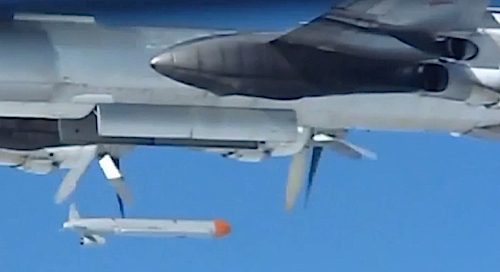
A Russian Tu-95MS long-range bomber drops an AS-15 Kent nuclear-capable cruise missiles from its bomb bay on May 8th. Six AS-15s were dropped from the bomb bay that day as part of a Russian nuclear strike exercise.
By Hans M. Kristensen
Less than a week after Russia carried out a nuclear strike exercise, the United States has begun its own annual nuclear strike exercise.
The exercises conducted by the world’s two largest nuclear-armed states come in the midst of the Ukraine crisis, as NATO and Russia appear to slide back down into a tit-for-tat posturing not seen since the Cold War.
Military posturing in Russia and NATO threaten to worsen the crisis and return Europe to an “us-and-them” adversarial relationship.
One good thing: the crisis so far has demonstrated the uselessness of the U.S. tactical nuclear weapons deployed in Europe.
Different Styles, Different Messages
Vladimir Putin’s televised commanding of the nuclear strike exercise – flanked by the presidents of Armenia, Belarus, Kyrgyzstan and Tajikistan in the Russian National Defense Command Center – made one thing very clear: Putin wanted to showcase his nuclear might to the world. Russian military news media showed the huge displays in the Command Center with the launch positions and impact areas of long-range nuclear missiles launched from a road-mobile launchers and ballistic missile submarines.

A map in the National Defense Command Center shows the launch points and impact areas of nuclear missiles launched across Russia. Click to see larger version.
Other displays and images on the Russian Internet showed AS-15 Kent (Kh-55) nuclear cruise missiles launched from a Tu-95 “Bear” bomber (six missiles were launched), short-range ballistic missiles, and air-defense and ballistic missile defense interceptors reportedly repelled a “massive rocket nuclear strike” launched against Russia by “a hypothetical opponent.”
Of course everything was said to work just perfectly but there is no way to known how well the Russian forces performed, how realistic the exercise was designed to be, or what was different compared with previous exercises. Russia conducts these exercises each year and Russian military planners love to launch a lot of rockets very quickly with lots of smoke and noise (it looks impressive on television). But the exercise looked more like a one-day snap intended to showcase test launching of offensive and defensive forces rather than a significant new development.
The STRATCOM announcement of the Global Lightning exercise was, in contrast, much more timid, so far limited to a single press release. Mindful of the problematic timing, the press release said the timing was “unrelated to real-world events” and that the exercise has been planned for more than a year. But some new stories nonetheless linked the two events.
The STRATCOM press release didn’t say much about the exercise scenario or what forces would be involved. Only bombers – whose operations are highly visible and would probably be noticed anyway – were mentioned: 10 B-52 and up to six B-2 bombers. But SSBNs and ICBMs also participate in Global Lightning (although not with live test launches as in the Russian exercise) as well as refueling tankers and command and control units.
As its main annual strategic nuclear command post/field training exercise, STRATCOM uses Global Lightning to verify the readiness and effectiveness of U.S. nuclear forces and practice strike scenarios from OPLAN 8010-12 and other war plans against potential adversaries. Last updated in June 2012, OPLAN 8010-12 is being adjusted to incorporate decisions from the Obama administration’s June 2013 nuclear weapons employment strategy.
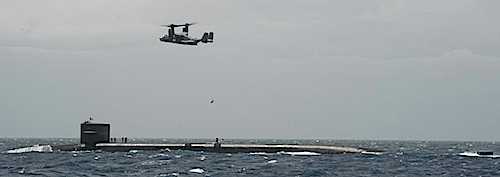
Although STRATCOM has only mentioned bombers participating in the Global Lightning 14 exercise, SSBNs and ICBMs also participate. This picture shows a V-22 Osprey delivering supplies to USS Louisiana (SSBN-424) during operations in the Pacific in 2012.
The previous Global Lightning exercise was held in 2012 (Global Lightning 2013 was canceled due to budget cuts) and is normally accompanied or followed by other nuclear-related exercises such as Global Thunder, Vigilant Shield, and Terminal Fury. In addition to strategic nuclear planning, STRATCOM supports regional nuclear targeting as well. The 2012 Global Lightning exercise supported Pacific Command’s Terminal Fury exercise in the Pacific and included several crisis and time-sensitive strike scenarios against extremely difficult target sets never seen before in Terminal Fury.
Back to Us and Them
One can read a lot into the exercises, if one really wants to. And some commentators have suggested that the exercises were deliberately intended as reminders to “the other side” of the Ukrainian crisis about the horrific military destructive power each side possesses.
I don’t think the Russian exercise or the U.S. Global Lightning exercise are directly linked to the Ukrainian crisis; they were planned long in advance. Nuclear weapons – and fortunately so – seem completely out of proportion to the circumstances of the situation in Ukraine.
Nonetheless, they do matter in the overall east-west sparing and the fact that the national leadership of Russia and the United States authorized these nuclear exercises at this particular time is a cause for concern. It is the first time nuclear forces have been rattled during the Ukrainian crisis. And because they are nuclear, the exercises add important weight to a pattern of increasingly militaristic behaviors on both sides.
Russia’s invasion of Crimea – bizarrely coinciding with Russia celebrating its defeat of a different invasion of the Soviet Union 73 years ago – to prevent loosing its Black Sea fleet area to an increasingly westerly looking Ukraine, and NATO responding by beefing up its military posture in Eastern Europe far from Ukraine to demonstrate “that NATO is prepared to meet and deter any threat to our alliance” – even though there are no signs of an increased Russian military threat against NATO territory in general – ought to have caused political leaders on both sides to delay the nuclear exercises to avoid fueling crisis sentiments and military posturing any further.
Instead, both sides now seem determined to stick to their guns and overturn the budding partnership and trust that had emerged after the Cold War. In doing so, the danger is, of course, that the military institutions on both sides are allowed to dominate the official responses to the crisis and deepen it rather than de-escalating and resolving it. No doubt, military hawks and defense contractors on both sides see an opportunity to use the Ukrainian crisis to get the defense budgets and weapons they have wanted for years but been unable to get because of budget cuts and the absence of a significant military “threat.”
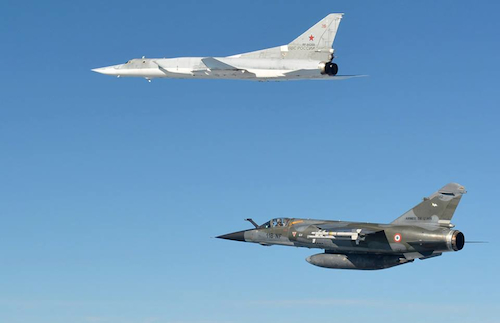
A French Mirage follows a Russian Tu-22M3 Backfire bomber over the Baltic Sea in June 2013. Three months earlier, two Russian Tu-22M3s escorted by four Su-27 Flanker fighters simulated a nuclear attack on two targets in Sweden.
Russia has already announced plans to add 30 warships to the Black Sea Fleet and widen deployment of navy and air forces to four additional bases in Crimea.
The Russian air force has resumed long-range training flights with nuclear aircraft and often violates the air space of other countries. In March 2013, two Tu-22M3 backfire bombers reportedly simulated a nuclear strike against two targets in Sweden (although the aircraft did not violate Swedish air space at that time).
It is almost inevitable that increased NATO deployments and defense budgets in eastern member countries will trigger Russian military counter-steps closer to NATO borders. One of the first tell signs will be the Zapad exercise later this fall.
For its part, NATO has already deployed ships, aircraft, and troops to Eastern European countries and is considering how to further change its defense planning to respond with “air, land and sea ’reassurances’” to “a different paradigm, a different rule set” (translation: Russia is now an official military threat), according to NATO’s military commander General Philip Breedlove and “position those ‘reassurances’ across the breadth of our exposure: north, center, and south.”
NATO General Secretary Anders Fogh Rasmussen echoed Breedlove’s defense vision during a visit to Estonia on May 1st, saying the Ukrainian crisis had triggered a NATO response where “aircraft and ships from across the Alliance are reinforcing the security from the Baltic to the Black Sea.”
Breedlove and Rasmussen paint a military response that appears to go beyond the Ukrainian crisis itself and involve a broad reinforcement of NATO’s eastern areas. Breedlove got NATO approval for the initial deployments and exercises seen in recent weeks, but the defense ministers meeting in Brussels in June likely will prepare more fundamental changes to NATO military posture for approval at the NATO Summit in Wales in September.
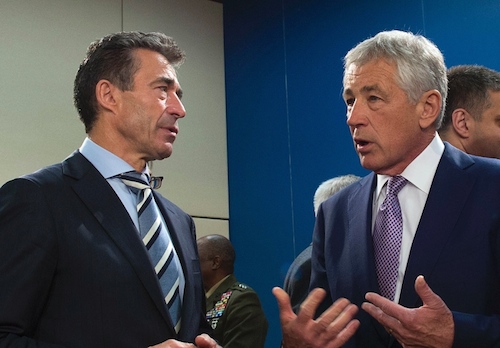
General Secretary Anders Fogh Rasmussen and other NATO officials describe a broad military reinforcement across NATO in response to Russia’s invasion of Ukraine, which U.S. Defense Secretary Chuck Hagel says requires NATO countries to increase their defense budgets.
Among other aspects, those changes will probably involve modifying NATO’s General Intelligence Estimate (MC 161) and NATO Ministerial Guidance to explicitly identify Russia, once again, as a potential threat. Doing so will open the door for more specific Article 5 contingency plans for the defense of eastern European NATO countries.
In reality, the military responses to the Ukraine crisis include many efforts that have been underway within NATO since 2008. The Baltic States and Poland have been urging NATO to draw up contingency plans for the defense of Eastern Europe against Russian incursions or military attack. Two obstacles worked against this: declining defense budgets (who’s going to pay for it?) and a reluctance to officially declare Russia to be a military threat to NATO. The latter obstacle is now gone and U.S. Defense Secretary Chuck Hagel’s is now publicly using the Ukraine crisis to ask NATO countries to increase their defense budgets.
After a decade of depleting its declining resources on an costly, open-ended war in Afghanistan that it cannot win, the Ukrainian crisis seems to have given NATO a sense of new purpose: a return to its core mission of defending NATO territory. “Russia’s actions in Ukraine have made NATO’s value abundantly clear,” Hagel said earlier this month, “and I know from my frequent conversations with NATO defense ministers that they do not need any convincing on this point.”
But one of the biggest obstacles to increasing defense budgets, Hagel said, “has been a sense that the end of the Cold War ushered in the ‘end of history’ – an end to insecurity, at least in Europe and the end [of] aggression by nation states. But Russia’s action in Ukraine shatter that myth and usher in bracing new realities,” he concluded, and “over the long term, we should expect Russia to test our alliance’s purpose, stamina, and commitment.”
In other words, it’s back to us and them.
It is difficult to dismiss Eastern European jitters about Russia – after all, they were occupied by the Soviet Union and joined NATO specifically to get the security guarantee so never to be occupied again. And Russia’s unlawful annexation of Crimea has completely shattered its former status as a European partner.
But the big question is whether NATO responding to Ukraine by beefing up its military inadvertently plays into the hands of Russian hardliners and will serve to deepen rather than easing military competition in Europe.
Why the Putin regime would respond favorably to NATO increasing its military posture in Eastern Europe is not clear. Yet it seems inconceivable that NATO could chose not to do so; after all, providing military protection is the core purpose of the Alliance.
At the same time, the more they two sides posture to demonstrate their resolve or unity, the harder it will be for them to de-escalate the crisis and rebuild the trust. Remember, we’ve been down that road and it took us six decades to get out.
Rather, it seems more likely that beefing up military forces and operations will reaffirm, in the eyes of Russian policy makers and military planners, what they have already decided; that NATO is a threat that is trying to encroach Russia who therefore must protect its borders and secure a sphere of influence as a buffer. Georgy Bovt’s recent analysis in Moscow Times of the Russian mindset is worthwhile reading.
The Irrelevance of Tactical Nuclear Weapons
So what does all of that mean for nuclear weapon in Europe? Remember, they’re supposed to reassure the NATO allies!
I hear many say that the Ukrainian crisis makes it very difficult to imagine a reduction, much less a withdrawal, of U.S. non-strategic nuclear weapons from Europe. Some people have even argued that the Ukrainian crisis could have been avoided if Ukraine had kept the nuclear weapons the Soviet Union left behind when it crumbled in 1991 (the argument ignores that Ukraine didn’t have the keys to use the weapons and would have been isolated as a nuclear rogue if it had not handed them over).
Only two years ago, NATO rejected calls for a withdrawal of U.S. nuclear weapons from Europe based on the argument that the deployment continues to serve an important role as a symbol of the U.S. security commitment to Europe and because eastern European NATO countries wanted the weapons in Europe to be assured about their protection against Russia. The May 2012 Defense and Deterrence Posture Review (DDPR), implementing the Strategic Concept from 2010, reaffirmed status quo by concluding “that the Alliance’s nuclear force posture currently meets the criteria for an effective deterrence and defense posture.”
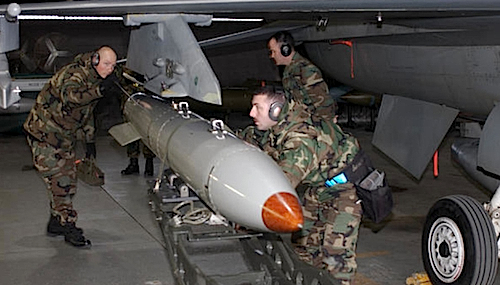
A B61 nuclear bomb trainer is loaded onto an F-16 somewhere in Europe, probably at Aviano Air Base in Italy. Some Eastern European NATO allies argue that the nuclear weapons provide important reassurance, but request deployment additional non-nuclear assets to deter Russia.
Yet here we are, only two years later, where the nuclear weapons have proven absolutely useless in reassuring the allies in the most serious crisis since the Cold War. Indeed, it is hard to think of a stronger reaffirmation of the impotence and irrelevance of tactical nuclear weapons to Europe’s security challenges than NATO’s decision to deploy conventional forces and beef up conventional contingency planning and defense budgets in response to Russia’s invasion of Ukraine and annexation of Crimea.
Put in another way, if the U.S. nuclear deployment was adequate for an effective deterrence and defense posture, why is it now inadequate to assure the allies?
In fact, one can argue with some validity that spending hundreds of millions of dollars on maintaining U.S. non-strategic nuclear weapons in Europe after the end of the Cold War has done very little for NATO security, except wasting resources on a nuclear capability that is useless rather than spending the money on conventional capabilities that can be used. It is about fake versus real assurances.
The deployment of U.S. nuclear weapons in Europe seems to be for academic and doctrinal discourses rather than for real security. In the real world they don’t seem to matter much and seem downright useless for the kinds of security challenges facing NATO countries today. But try telling that to current and former officials who have been spending the past five years lobbying and educating Eastern NATO governments on why the weapons should stay.
This publication was made possible by a grant from the Ploughshares Fund. The statements made and views expressed are solely the responsibility of the author.
While it is reasonable for governments to keep the most sensitive aspects of nuclear policies secret, the rights of their citizens to have access to general knowledge about these issues is equally valid so they may know about the consequences to themselves and their country.
Nearly one year after the Pentagon certified the Sentinel intercontinental ballistic missile program to continue after it incurred critical cost and schedule overruns, the new nuclear missile could once again be in trouble.
“The era of reductions in the number of nuclear weapons in the world, which had lasted since the end of the cold war, is coming to an end”
Without information, without factual information, you can’t act. You can’t relate to the world you live in. And so it’s super important for us to be able to monitor what’s happening around the world, analyze the material, and translate it into something that different audiences can understand.